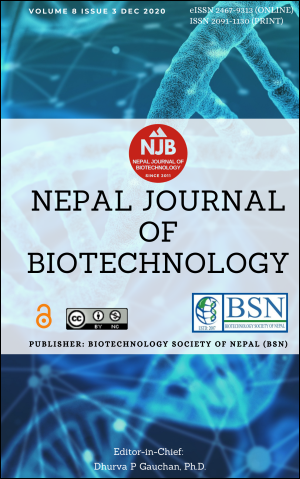Screening of Actinomycetes from Soil for Antibacterial Activity
DOI:
https://doi.org/10.3126/njb.v8i3.33664Keywords:
Actinomycetes, Inhibitory activity, Isolates, Antimicrobial, AntibioticsAbstract
Actinomycetes are Gram positive, free living saprophytes which are distributed in soil as one of the major populations and are primary source of antibiotics. This study was carried out with a quest to isolate actinomycetes from soil samples of different places and assess their antibacterial activity. Isolation of actinomycetes was carried out by serial dilution of soil sample followed by spread plate method. The antimicrobial extract was extracted using ethyl acetate. Assessment of antimicrobial activity was performed by using Agar cup plate assay against test organisms (Pseudomonas aeruginosa, Escherichia coli, Klebsiella pneumoniae, Salmonella typhi, Salmonella paratyphi, Bacillus subtilis, Staphylococcus aureus). Antibacterial activity was tested against Methicillin Sensitive Staphylococcus aureus and Methicillin Resistant Staphylococcus aureus in the isolates having effective inhibitory activity against Staphylococcus aureus. From 15 soil samples of 12 different locations, 121 actinomycetes isolates were isolated. Among them, 58 (47.9%) isolates were inhibitory against at least 1 test organism in primary screening, of which 22 isolates effective against more than 1 test organism was chosen for secondary screening. Out of them, 8 were inhibitory against 2 test organisms while 14 were inhibitory against 3 test organisms. Staphylococcus aureus was found to be the most susceptible test organism with its susceptibility against 12 actinomycetes isolates. Among 12 isolates effective against Staphylococcus aureus, 10 were found to have an inhibitory effect against Methicillin Susceptible Staphylococcus aureus while 6 were found to have inhibitory effect against Methicillin Resistant Staphylococcus aureus strain. The findings of this study highlight the inhibitory potential of actinomycetes and the need for further investigation for obtaining novel antimicrobial agents from actinomycetes from various unexplored areas.
Downloads
Downloads
Published
How to Cite
Issue
Section
License
Copyright Notice:
The manuscript submitted to NJB must be an original contribution, not previously published and should not be under consideration for publication elsewhere. When the manuscript is accepted for publication, the authors agree to automatically transfer the copyright of the article to the publisher. It should grant permission to any third party, in advance and in perpetuity, the right to use, reproduce or disseminate your article, according to the NJB copyright and license agreement.
Authors transfer copyright to the publisher as part of a journal publishing agreement but have the rights to: Share their article for Personal Use, Internal Institutional Use and Scholarly Sharing purposes, with the NJB applies the Creative Commons Attribution-NonCommercial CC BY-NC license to all the works we publish after Jun 2020 (Before it was CC BY-NC-ND). Under this license, authors agree to make articles legally available for reuse, without permission or fees, for virtually any non-commercial purpose. Anyone may remix, adapt, and build upon your work non-commercially, and although their new works must also acknowledge you and be non-commercial, they don’t have to license their derivative works on the same terms. More details on CC BY-NC refer to its Licence Deed and Legal Code.






